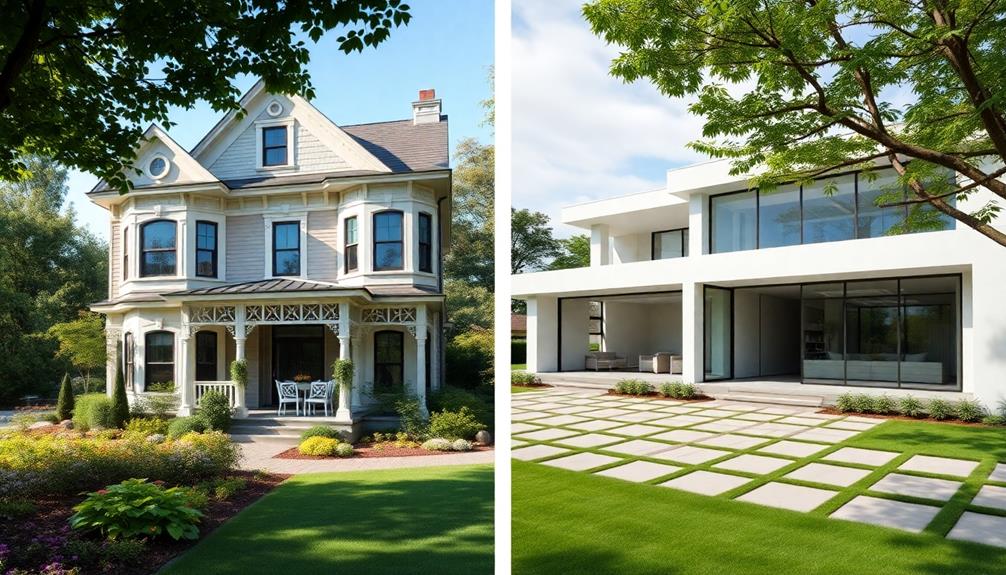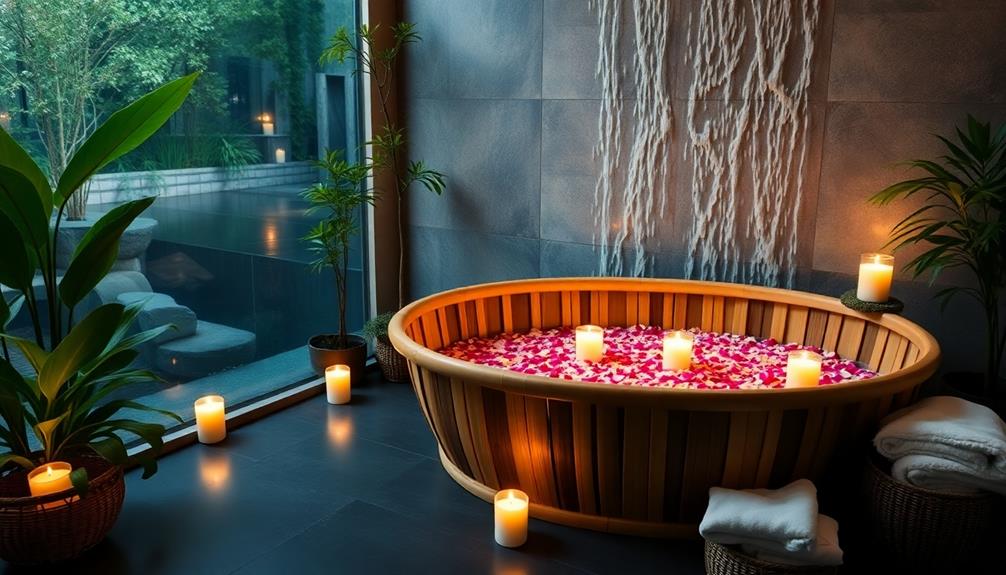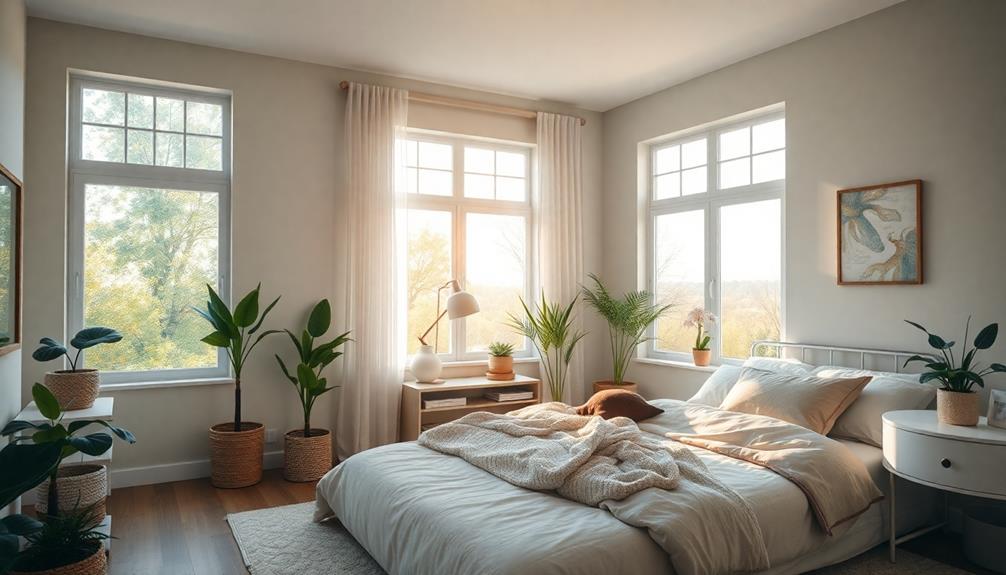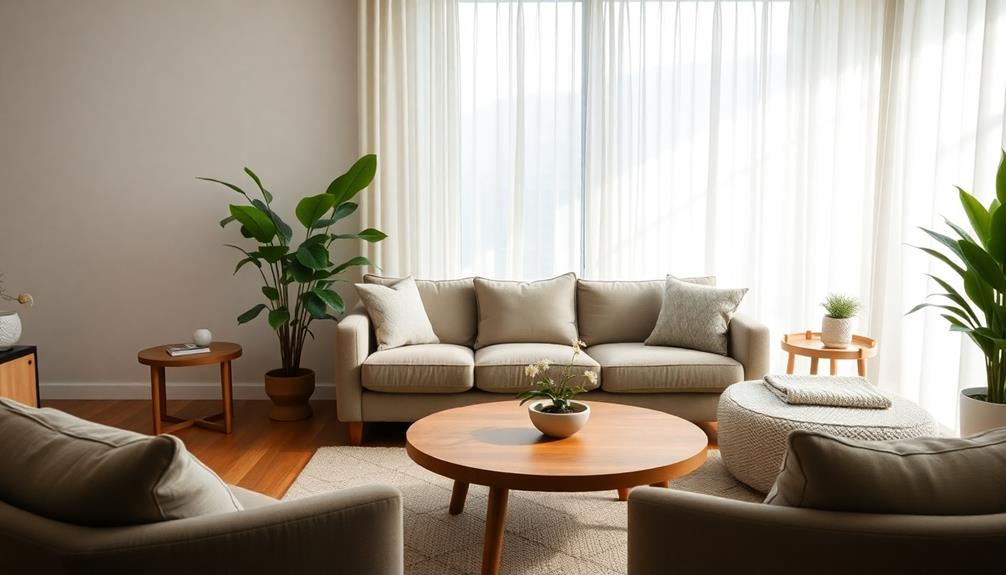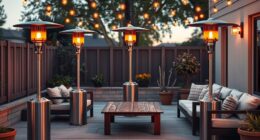When you compare traditional and modern homes, you'll find clear distinctions. Traditional homes, like Victorian and Colonial styles, boast rich details and compartmentalized rooms, creating a nostalgic feel. They offer privacy and familiarity through unique layouts. In contrast, modern homes focus on open-concept designs, using industrial materials for a sleek, minimalist aesthetic. Large windows invite natural light and encourage communal living. Furniture trends also differ, with traditional spaces showcasing ornate pieces and modern homes favoring clean lines. Understanding these differences enhances your appreciation of each style's unique charm and functionality. There's plenty more to explore on this topic.
Key Takeaways
- Traditional homes feature intricate details and compartmentalized rooms, promoting privacy and distinct functional zones.
- Modern homes emphasize open-concept layouts, maximizing space for communal living and flexibility.
- Window designs differ; modern homes use large windows for natural light, while traditional homes rely on lamps and overhead lighting.
- Furniture in traditional homes is often ornate and heavy, whereas modern homes prioritize sleek, minimalist designs for functionality.
- Both architectural styles reflect cultural significance, preserving history and adapting to contemporary societal needs.
Architectural Styles Comparison
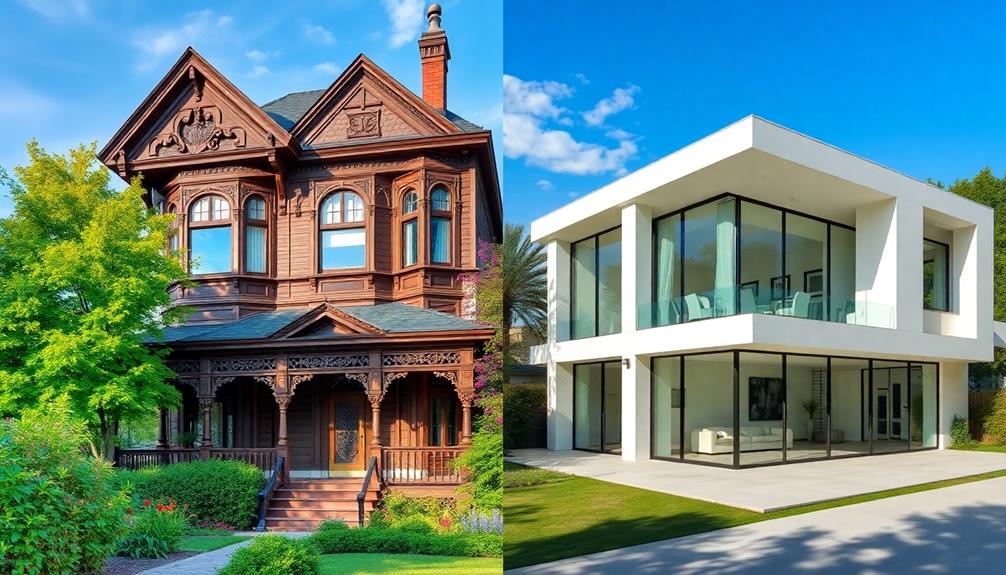
When you explore architectural styles, you'll notice a striking contrast between traditional and modern homes.
Traditional houses, like Victorian or Colonial, showcase historical influences with intricate details and cultural significance. You'll find rich woodwork, ornate moldings, and a sense of nostalgia that evokes the past.
In contrast, modern homes embrace industrial materials such as steel and concrete. They prioritize functionality and a minimalist aesthetic, characterized by clean lines and open spaces.
While traditional designs connect you to history, modern architecture focuses on innovation, sustainability, and creativity.
Each style tells a unique story about society's values and preferences, allowing you to appreciate the evolution of living environments across different eras.
Variances in Floor Plans
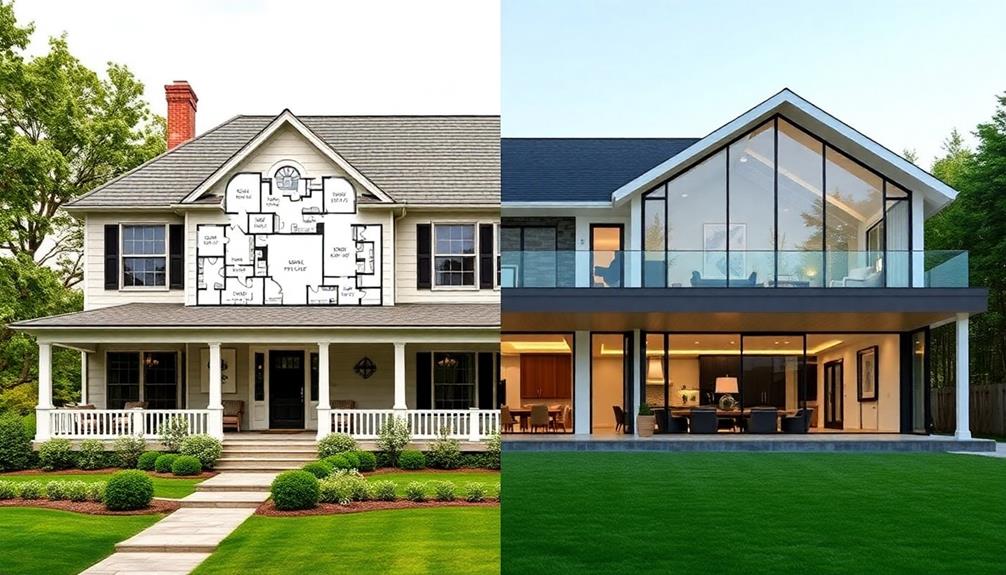
Floor plans serve as the blueprint for how we experience our homes, revealing key differences between traditional and modern designs.
In traditional homes, you'll notice smaller, compartmentalized rooms designed for specific purposes, promoting privacy and distinct zones. Each space feels separate, allowing you to enjoy solitude or focused activities. Additionally, the unique atmosphere created by the layout can enhance the enjoyment of daily rituals, such as brewing coffee in a cozy kitchen nook, where one can appreciate the nuances of brewing methods.
On the other hand, modern homes embrace open-concept layouts, encouraging a seamless flow between areas. This design choice fosters connectivity, making it easier for family members to interact and share experiences. Multi-functional spaces in modern houses support versatility, allowing you to adapt the environment to your needs.
Ultimately, these variances in floor plans reflect broader lifestyle preferences, prioritizing either compartmentalization or openness in how you live and engage with your space.
Differences in Room Layout
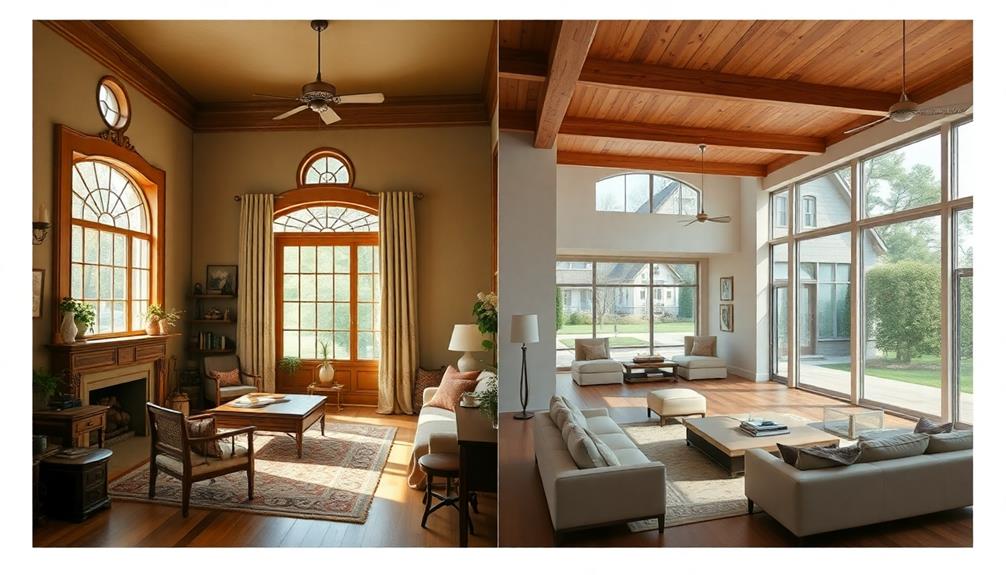
Many homeowners appreciate the stark differences in room layouts between traditional and modern designs.
Traditional homes typically feature smaller, single-purpose rooms, where each space serves its distinct function. You'll often find foyers and halls that create separation, ensuring privacy and defined zones for family activities. This design choice often reflects a focus on personal influences shape individual design styles, emphasizing comfort and familiarity.
In contrast, modern designs embrace open-concept layouts, eliminating walls to foster a seamless flow between living areas. This approach encourages communal living, allowing for multi-functional spaces that adapt to your lifestyle. Many of these modern designs also focus on maximizing natural light and incorporating sustainable materials, creating a visually appealing and environmentally friendly living space. With the rise of remote work and online learning, there is a growing demand for versatile home environments that can accommodate various activities. If you’re looking to learn more about incorporating modern design principles into your home, consider enrolling in one of the top online interior design programs available. These programs offer comprehensive courses and resources to help you create the perfect modern living space.
You'll notice how modern layouts maximize square footage and promote connectivity, making gatherings more inviting.
Ultimately, the choice between these layouts reflects your personal preference for either privacy or an open, airy environment that encourages interaction among family members.
The Concept of Open Design
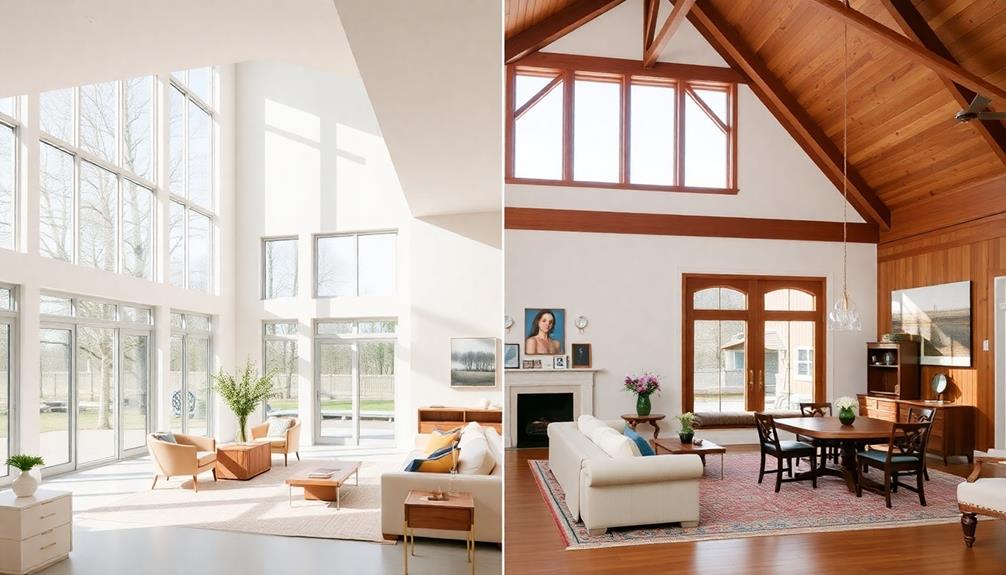
How does open design transform the way we live and interact within our homes? With fewer walls, you'll find your living spaces flow together seamlessly, promoting connectivity among family members. This layout enhances flexibility, allowing areas to adapt to various activities, whether it's cooking, entertaining, or relaxing.
| Feature | Traditional Homes | Modern Open Design |
|---|---|---|
| Room Separation | Compartmentalized | Seamless flow |
| Functionality | Single-purpose rooms | Multi-functional spaces |
| Social Interaction | Limited connectivity | Enhanced togetherness |
Embracing open design reflects contemporary lifestyles, making it easier for you and your loved ones to share experiences and create lasting memories in a spacious, inviting environment.
Window and Lighting Choices
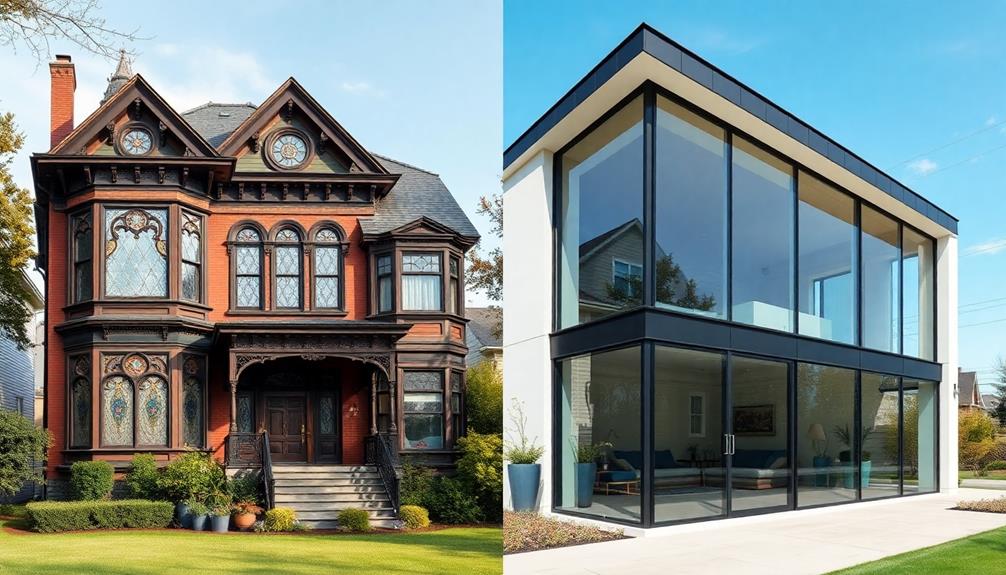
Open design not only enhances connectivity within living spaces but also greatly influences how light enters your home.
In modern homes, you'll find a focus on maximizing natural light, creating bright and airy environments. This emphasis on light can also be reflected in the choice of technology for entertainment, such as top projectors for gaming enthusiasts, which can provide vibrant visuals that complement the bright atmosphere.
Here are some key differences in window and lighting choices:
- Large Windows: Modern homes often feature expansive windows to flood spaces with daylight.
- Strategic Placement: Windows are positioned to optimize light flow and views, enhancing the overall atmosphere.
- Energy Efficiency: Modern designs incorporate energy-efficient windows that reduce reliance on artificial lighting.
- Natural Light Emphasis: Traditional homes typically rely more on lamps and overhead lights, while modern spaces prioritize daylight.
Choosing the right windows and lighting can transform your living experience, making it brighter and more inviting.
Furniture and Decor Trends
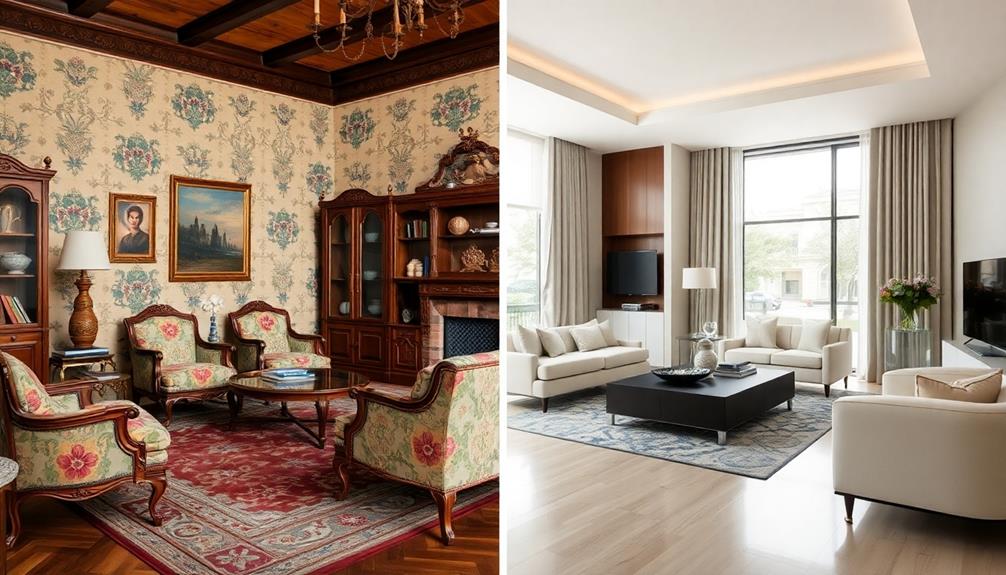
Aesthetic appeal often plays a pivotal role in defining the character of a home, particularly when comparing furniture and decor trends in traditional versus modern styles.
In traditional homes, you'll find ornate, dark, and heavy furniture that reflects craftsmanship and historical themes. Rich fabrics and intricate details create a warm, inviting atmosphere.
On the other hand, modern homes embrace sleek, minimalist designs with bold color palettes. You'll notice clean lines and functional elements that prioritize simplicity and practicality.
Decor in modern settings often leans towards abstract art and innovative pieces, creating an airy, spacious feel.
This contrast in furniture styles not only highlights different design philosophies but also mirrors broader lifestyle choices in today's world.
Cultural Significance of Homes
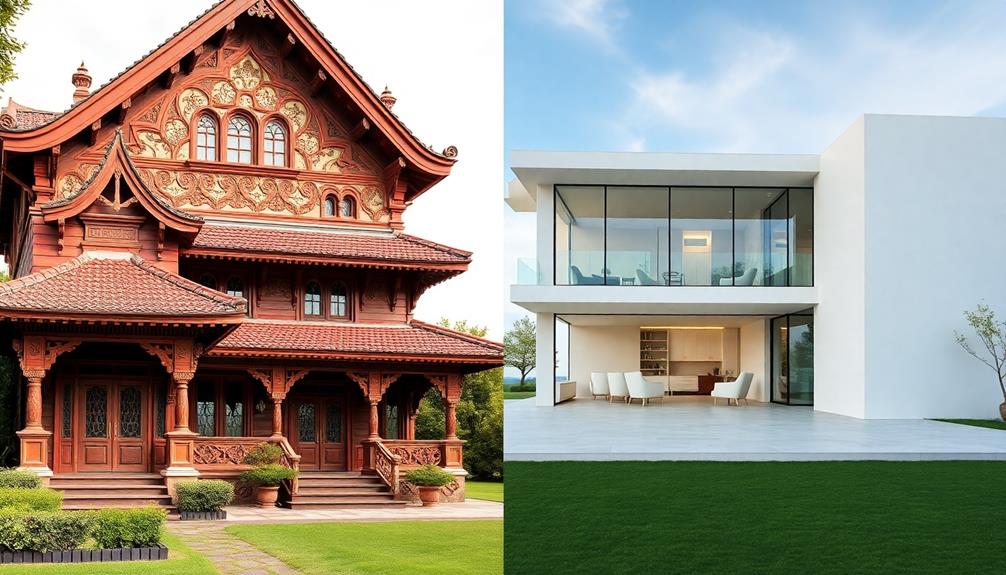
The cultural significance of homes goes beyond mere shelter; they serve as reflections of our values, traditions, and heritage.
When you think about it, your home tells a story about who you're and where you come from. Here are some key aspects to reflect upon:
- Cultural Heritage: Traditional homes preserve historical architectural styles and local craftsmanship.
- Societal Evolution: Modern designs reflect current lifestyles and societal shifts, showcasing adaptability.
- Community Identity: Both styles foster a sense of belonging and connection within neighborhoods.
- Personal Expression: Your home is a canvas that expresses your individuality, preferences, and experiences.
Understanding the cultural significance of homes helps you appreciate the deeper connections we share with our living spaces.
Frequently Asked Questions
How Do Traditional and Modern Homes Differ in Energy Efficiency?
When considering energy efficiency, modern homes typically use larger windows and sustainable materials to maximize natural light and reduce energy consumption. Traditional homes often rely more on artificial lighting and less efficient insulation methods.
What Are the Maintenance Needs for Traditional Versus Modern Homes?
Isn't it fascinating how maintenance needs differ? You'll find traditional homes require more upkeep, like roofing and siding, while modern designs often use durable materials, making them easier to maintain and less time-consuming overall.
Which Home Style Is Generally More Affordable to Build?
When considering affordability, modern homes often cost less to build due to simpler designs and efficient materials. You'll find that streamlined construction methods and open layouts can greatly reduce overall expenses compared to traditional styles.
How Do Environmental Factors Influence Home Design Choices?
When you're contemplating home design, environmental factors subtly guide your choices. You'll find elements like natural light, insulation, and materials playing pivotal roles, enhancing sustainability while harmonizing your dwelling with its surroundings.
What Are the Most Popular Materials Used in Each Architectural Style?
When considering popular materials, you'll find traditional homes often use wood, brick, and stone for warmth and character, while modern designs favor steel, glass, and concrete for sleekness and innovative aesthetics.
Conclusion
In the clash of traditional charm and modern sleekness, you find a world of possibilities. Imagine the cozy warmth of intricate woodwork juxtaposed against the clean lines of minimalist spaces. Each style offers a unique lens through which to view the past and present—traditional homes wrap you in nostalgia, while modern designs propel you into innovation. As you navigate these contrasts, you'll appreciate how architecture not only shapes your surroundings but also reflects your evolving lifestyle and values.
